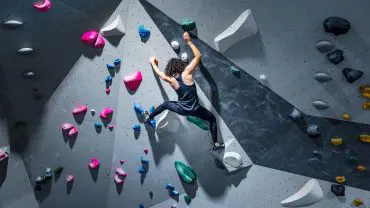What is slacklining? In a nutshell it’s all about balance. Slackliners stand, walk and even perform amazing stunts on a thin strip of webbing fixed between any two anchor points including trees, over rivers and canyons or even between two car bumpers.
Slacklining has evolved into a legitimate extreme sport, popular with adrenaline junkies and thrill seekers the world over. Yet, it’s also used for physiotherapy and as a way to improve balance and core strength. It’s also just a fun thing to do!
It was first seen in California’s famous Yosemite National Park in the 1960s. Climbers used anything they could get their hands on including chains, steel cables and climbing ropes, though it wasn’t until the summer of 1983 when slacklining as a sport was born.
Climbers Jeff Ellington and Adam Grosowsky rigged up a 16 metre length of tubular webbing at Yosemite’s Lost Arrow Spire. Neither were successful on their first try but word got out and it spread very quickly. The sport of slacklining took off and even today it’s growing in popularity.
Here, we’ll answer the question ‘what is slacklining’ and let you know what you need to attempt slackline for beginners!
What is a Slack Line?

Low line practice in the park (Photo: Christoph Jorda via Getty Images)
The key difference between slacklining and tightrope walking is what you walk on. A slackline is flat webbing made of nylon or polyester, is usually between two and five centimetres wide and can be any length – in fact if you carry on to the end of the article you’ll discover some mind-blowing slacklining world records!
The webbing isn’t pulled tight, it’s stretchy and bouncy and is tensioned much less than a tightrope, causing the line to be extremely dynamic.
There are different styles of slacklining which all require a unique set-up –
Lowlining
This is slackline for beginners. It uses the widest webbing (around 5cm) and is usually ratcheted between two trees no more than about a metre off the ground – so if you do fall, the potential for injury is pretty low. The webbing is set with a higher than usual tension so novices can find their feet more easily.
Longlining
Fairly self-explanatory, these are lines over 30 metres long and require a more advanced setup capable of securing and tensioning long lines. Like most slacklines they can be set up anywhere and a favourite of longliners is traversing water.
Highlining
Again it does exactly what it says on the tin, and when you ask the question ‘what is slacklining’, this is what most people have in mind. Rigged high above terra firma, (often hundreds or even thousands of metres), it’s the ultimate challenge for slackliners and should only be attempted by the most experienced. It requires complex safety harnesses, back-up systems and rigging equipment of they type used by the world’s most experienced mountaineers.
Fitness Line
These are short, wide lines used for crossfit and yoga, as well as specific strength and balance training. These lines are usually tensioned between two stands and are the most popular choice for indoor slackline.
Anyone Can Slackline

Steady on! (Photo: Cavan Images via Getty Images)
The question ‘what is slacklining’ has a different answer today than it did in the early 1980s! The sport has come on leaps and bounds since its formative days in Yosemite National Park. Today, there are all sorts of different lines and equipment manufactured specifically for slacklining, including the indoor slackline.
Contrary to popular belief, the sport of slacklining isn’t just for circus performers, acrobats and high-octane daredevils. In fact anyone of any age can do it. It’s used as a training aid for other sports that require an element of balance and manoeuvrability, as well as a yoga discipline, as a fitness regime in itself and even in physiotherapy.
Slacklining World Records

High Altitude Slackline (Photo: China News Service via Getty Images)
These are the guys that take slacklining to the extreme! Here’s a rundown of slacklining world records, correct at time of writing:
Longest Slackline Walk
In July 2021, four German slackliners – Quirin Herterich, Lukas Irmler, Ruben Langer and Friedi Kühne walked a line 2,130 metres long over the Lapporten valley in Sweden’s Abisko National Park at a height of 600 metres.
Highest Slackline Walk
Brazilian Rafael Zugno Bridi walked 18 metres between two hot-air balloons a staggering 1,901 metres above Santa Caterina in Brazil in December 2021. The slackline was 2.5cm wide and he was at an altitude twice that of the Burj Khalifa, the world’s tallest building.
Fastest 100m on a Slackline
The quickest time anyone has done a 100m slackline walk was 1 minute 59.73 seconds by French daredevil Lucas Milliard on a slackline 70 metres above Hailuogou National Glacier Forest Park in Sichuan, China in 2016.
Longest Slackline Walk over Water
German Julian Mittermaier walked 674.18 metres over Wanfo Lake in China in 2017. It took him 59 minutes 26 seconds to make the crossing.
Slacklining Explained

Practising slacklining (Photo: SOPA Images via Getty Images)
So now you know the answer to the question ‘what is slacklining’, you’ll never look at your exercise regime in the same way again, and if you’re searching ‘slackline for beginners’, there’s some great advice and starting options available online.











